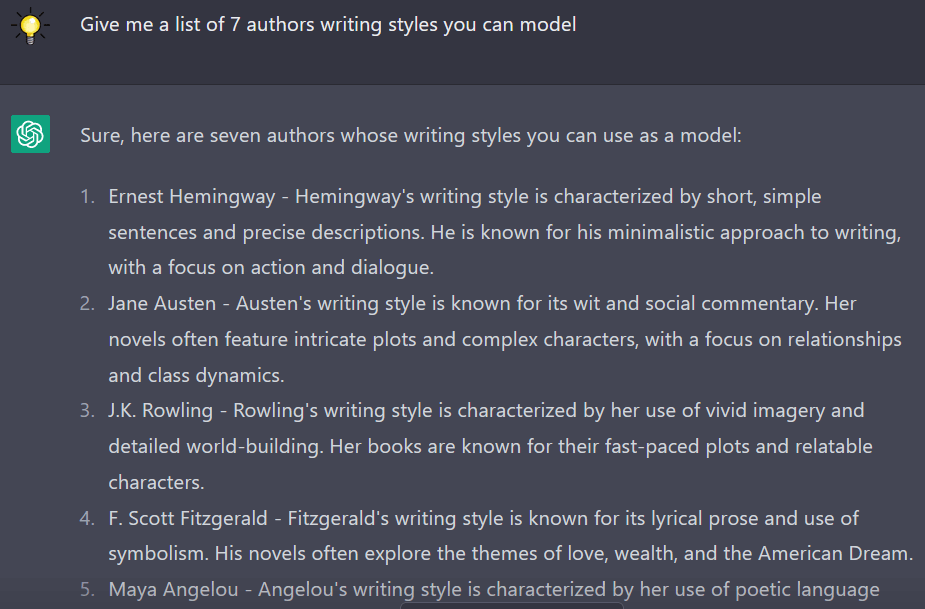ChatGPT is a wonderful productivity tool that can save you a lot of time and even money, if you use it correctly.
Unfortunately, most people don’t use it correctly.
Now, many marketers immediately start generating articles and ebooks that they can sell without changing, or even tweaking the content, and that is one of the worst ways to approach ChatGPT.
First, you need to get your mindset right when it comes to using ChatGPT!
You need to think of ChatGPT as a personal assistant that helps you get things ready, but ultimately, you’ll transform the generated text and make it reader-friendly and engaging.
It’ll help you suggest topics, build outlines, and can even critique your content, but in order to be successful, you must bring the human component to everything.
If you’re trying to flood the internet with blog posts created by ChatGPT… or you’re contemplating ‘carpet bombing’ the Kindle marketplace with tons of books generated by ChatGPT – you are on the WRONG track.
This tool is best used for research, outlining, idea generation and other activities that are part and parcel of content creation.
ChatGPT is not designed, and should not be used, to create your content for you from start to finish. You’ll never end up with compelling content that moves your site traffic needle or increases your SEO efforts if you don’t do your part.
Once you have the necessary components, you can write out the content on your own or hire a freelance writer to flesh out an article based on ChatGPT’s ‘work’.
The goal here is to use ChatGPT to shortcut the process by getting it to do the heavy lifting. You’re not relying on it entirely to produce content.
Always bear in mind that ChatGPT is a text generator, NOT a writer.
1. Be specific with your prompts.
If you want ChatGPT to give you an outline, you’ll need to use the word ‘outline’ in your prompt. If you don’t use the prompt correctly, you’ll get an entire article instead of an outline.
If the response is too wordy, you may ask it to give you a response in ‘point format’. The more specific you are with your request, the better the response you’ll get.
2. Take a step-by-step approach and be patient.
While you’re having a conversation with ChatGPT, it’s not the same as having a conversation with a human who can process multiple pieces of information at once.
With ChatGPT, if you ask for too much, you’ll only ‘confuse’ the AI tool and the response you get won’t be favorable. You’re better off asking it for responses in stages.
Let’s assume you want to write an article about weight loss supplements.
Your first step may be to ask it to create an outline for you.
And here’s what ChatGPT gave me in return:
Title: Navigating the World of Weight Loss Supplements: A Comprehensive Guide
I. Introduction
A. The Growing Interest in Weight Loss Supplements
B. The Need for Informed Decision-making
II. Understanding Weight Loss Supplements
A. What Are Weight Loss Supplements?
B. How Do They Work?
C. Different Types of Weight Loss Supplements
III. The Science Behind Weight Loss
A. The Role of Metabolism and Energy Expenditure
B. Appetite Regulation and Weight Management
IV. Factors to Consider Before Using Supplements
A. Consulting a Healthcare Professional
B. Potential Side Effects and Safety Concerns
C. Realistic Expectations and Healthy Lifestyle Changes
V. Exploring Major Players in the Supplement Industry
A. Company A: Product Range, Ingredients, and Reputation
B. Company B: Clinical Studies and Research-backed Formulas
C. Company C: Transparency and Consumer Reviews
VI. Key Ingredients in Weight Loss Supplements
A. Green Tea Extract: Boosting Metabolism and Fat Oxidation
B. Garcinia Cambogia: Appetite Suppression and Fat Blockage
C. Caffeine: Increasing Energy Expenditure and Alertness
D. Conjugated Linoleic Acid (CLA): Enhancing Fat Loss and Muscle Growth
VII. Separating Facts from Hype: Evaluating Supplement Claims
A. Understanding Label Claims and Marketing Jargon
B. Identifying Red Flags and Unrealistic Promises
VIII. Making an Informed Decision
A. Researching and Comparing Products
B. Reading User Reviews and Testimonials
C. Considering Personal Health and Goals
IX. The Importance of a Holistic Approach
A. Combining Supplements with a Balanced Diet
B. Incorporating Regular Physical Activity
C. Managing Stress and Prioritizing Sleep
X. Conclusion
A. Empowering Yourself with Knowledge
B. Embracing Sustainable and Health-Centric Changes
C. Achieving Weight Management Goals Safely and Effectively
The next prompt could be a request for suggested supplements to recommend.
The third prompt could be a request for ChatGPT to list out the benefits and disadvantages for each of the individual supplements.
By doing this in ‘stages’, it’ll keep things simple and organized. Breaking down a request into multiple queries will make the process smoother and more rewarding.
If you asked ChatGPT for everything at once in one prompt, it will struggle to create a coherent response, and it’s going to miss a considerable amount of valuable information.
3. Less is more, always.
ChatGPT works on a token system. If your prompt is overly long and wordy, ChatGPT’s response will be shorter because it has to reply within the token limit.
So it’s best to keep your prompts concise and highly specific.
Always remember that you’re not dealing with a human being. There’s no real creativity or life experience here. It’s sophisticated machine-learning and nothing more, meaning, you’ll only get back what you specifically give it.
4. Keep your conversations organized.
You’ll want to name each conversation based on the topic you’re generating content for. It’s easy to go off into tangents while playing around with ChatGPT, but, inevitably, that will cut into your productivity.
If your conversations are too long, or you ask for responses on unrelated topics, later when you want to reference your conversation, it’ll be a chore.
You’ll waste time scrolling through long conversations just to find what you’re looking for. So, keep your ChatGPT dashboard organized and save your most frequently used prompts in a text file on your computer or notes app in your phone.
5. Keep your tone conversational and as human as possible.
ChatGPT was built to have a conversation. So, you’ll want to speak to it in a way you communicate with a friend. Avoid technical jargon or industry-specific terms. There’s no need to be overly formal in your prompts.
This is a fun tool. Take a lighthearted approach, and you’ll discover that you enjoy using it.
6. Practice makes progress, especially when it comes to prompts.
The user interface of ChatGPT is simple, neat, and intuitive. That said, the more you practice using it, the better you’ll get at using prompts and knowing ChatGPT’s limitations. You can also familiarize yourself with its features such as: outlining, summarizing, rephrasing and so on.
As you get the hang of using ChatGPT, you’ll naturally come up with more innovative and creative ways to use it effectively.
Spend 20–30 minutes a day using it, and within a week or two, you’ll be proficient at using this awesome tool.
7. Provide examples and context every chance you get.
If you want ChatGPT to provide content that models a specific style, you should include an example in your prompt.
The screenshot below, borrowed from our article on using ChatGPT to help write fiction, showcases the many different styles that the tool offers.

Similarly, depending on the tone and complexity of your article, you could ask ChatGPT to write the content for a fifth grader… or you could ask it to write it in a formal tone with impressive language.
ChatGPT will give you totally different results based on your examples and input.
Ultimately, ChatGPT’s effectiveness will be a result of your competence when it comes to using it.
The more specific, creative, and patient you are, the better the responses you’ll generate with this tool. Use it discerningly, and you’ll take your content creation to the next level in the shortest possible time.





